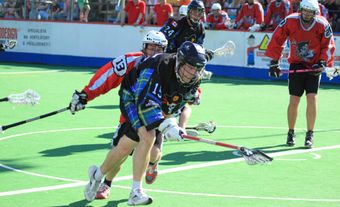
Badminton
Badminton is a game played on a rectangular court (13.4 m by 6.1 m) divided into equal halves by a 1.524 m high net by 2 players (or 4 players in doubles), whose object is to hit the shuttlecock ("shuttle") over the net and onto the floor of the opposing side's court. A rally is lost if the shuttle is hit into the net, or over the net but outside of the opposing side's court. The rally is also lost if, for example, the shuttle touches the receiver or the receiver's clothing, or if the receiver hits it before it crosses the net. Very light racquets are used to hit the specially designed shuttlecock with great speed or skilful deception. Top-class play demands a wide range of motor skills, excellent eye-hand co-ordination and superb physical fitness.
History
Early versions of badminton were played about 2000 years ago in China, Thailand, India and Greece. Some sources say it was British army officers serving in Poona, India, who adopted the ancient game, possibly taking it home when on leave during the 1860s. It may have first been played in England at the Duke of Beaufort's country estate, called Badminton House. Hence "badminton" was born and the game was soon adopted at several English seaside resorts and in the London suburbs. The Badminton Association of England was founded in 1893 and wrote the laws of the game, which have changed very little since.
Badminton in Canada
Military personnel introduced badminton to Vancouver, BC, in the late 1890s. It was slow to spread to other regions, though there is evidence of it being played in Ottawa in 1900 and the first Canadian club was founded in Montréal in 1907. The first open tournament was the BC Championships (1913-14 season). After WWI, the Canadian Badminton Association (CBA) was founded (1921-22) and the first Canadian Championships were held in Montréal in 1922. The greatest initial stimulus to the game in Canada came in the fall of 1925 when a British team toured the country and provided the impetus to erect specially built halls in many cities. Five years later a similar tour was arranged; both British teams were captained by Sir George Thomas, who donated the Thomas Cup to the International Badminton Federation (IBF) in 1939. During the 1930 tour Jack Purcell of Guelph, Ont, defeated the 4 best British players, and in 1933 he was world professional champion. Dorothy Walton dominated Canadian women's play in the 1930s and won the All England women's singles title in 1939.
International Competition
Badminton has been included in the Commonwealth Games since 1966, and Canadians have won gold medals in the men's singles and women's doubles events, and silver and bronze medals in all the other events. In team competition in all Commonwealth Games, Canada has consistently followed England's gold medal achievements by winning all the silver medals contested. Canadians became Pan American Champions in 1988 with a clean sweep of the individual and team events. Badminton's status in the world of sport was enhanced in 1985 when the International Olympic Committee announced its inclusion in the 1992 Summer Olympic Games as a full medal sport. Canadian teams now compete with moderate success at all other major events such as the All England Championships, the Thomas Cup (Men's Team World Championship), the Uber Cup (Women's Team World Championship), the Sudirman Cup (World Mixed Team Championship) and individual World Championships.
The World Cup competitions took place between 1981 and 1996 with the intention of enabling top players to earn greater levels of prize money. It has been superseded by the World Grand Prix series, which is a singles and doubles competition open to top ranked players who qualify and are members of a Member Association affiliated to the IBF. The IBF is governed by a general meeting of delegates from the 138 country member associations. The Badminton Players' Federation promotes and helps to safeguard the interests of top international players and is represented on the IBF Council. In 1999, the strongest international players were from Asia and Denmark. To illustrate Canadians' status by world standards, their highest rankings are women's singles 57th, men's singles 107th, women's doubles 29th and mixed doubles 38th.
While such international and elite competition is important, the real strength of the game in Canada is in the over 2 million recreational players and in the volunteers from local club to the national executive level who make it all happen. The 10 provincial and 2 territorial associations are members of Badminton Canada. Badminton Canada (formerly CBA) acts on their behalf, in Canada and internationally, in certain matters judged vital to the continued growth and conduct of the sport. As Canada's sole representative for badminton internationally, and as custodian of the laws of the game, Badminton Canada has become the central element in the overall structure of Canadian badminton.

 Share on Facebook
Share on Facebook Share on X
Share on X Share by Email
Share by Email Share on Google Classroom
Share on Google Classroom


